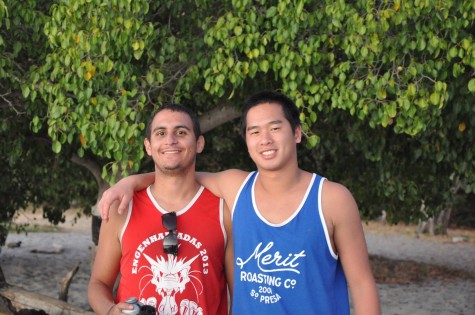Bluhm and O’Toole tag turtles in Costa Rica
The sound of waves lapping on the soft cool beach could be heard as a group of students traversed through the sand dunes under the moonlight. Although they were sleep deprived, every single one of them kept their eyes and ears alert to find the reptile they had come searching for.

Junior Jonny Addicks O’Toole learns about turtles with a researcher.
Junior Jonny Addicks O’Toole was one of the two students from St. Paul Academy and Summit School who went to Costa Rica from Jan. 6-13. After traveling to Costa Rica to study ants last year as a sophomore, O’Toole wanted to go back to the beautiful country and learn more about other animals.
“First of all, it grabbed my attention ’cause it’s turtles, right? Also I wanted some more hands-on experience with biology, marine biology, ’cause it might be what I want to do in college,” O’Toole said.
The purpose of the trip was to test the viability of drones so the researches who lead the expedition could expand their data collection. O’Toole and the group of students were also given the opportunity to track down and tag different species of turtles as well.
Nathan Robinson, Christopher Gatto, and Pilar Santidrian Tomillo were the three researchers who conducted and coordinated the experiments on the trip. Robinson does research at Purdue University and Tomillo at Drexel University.
O’Toole dove right into the experiment when he arrived. He discovered a leatherback turtle about 20 meters from the entrance of the beach laying its eggs. The leatherback had to be relocated otherwise the waves would drown the eggs or the egg pit would be prone to stepping on.
“It was a really strong turtle, it would hit your arms and the legs were all slimy,” O’Toole said.
About 75 eggs were collected from that egg pit.
Three days into the experiment, O’Toole and the rest of his group came up with the idea to program autonomous drones that could sweep the beaches early in the morning for turtle tracks so as to provide a more efficient way of detecting where egg pits were. They programmed wave points along the beach that the drones could follow 40 meters or so up in the air with their cameras attached to infrared lights.
“I think [that] was probably one of the biggest accomplishments on the trip because first of all, it’s easier than walking down the beach again and again and again, and you can program the drone to go to different beaches, so if [the beaches are] inaccessible for the researches, you can just program the drone to fly there and bring back data so it expands the amount of data you can collect around that area,” O’Toole said.
I wanted some more hands-on experience with biology, marine biology, [because] it might be what I want to do in college,
— junior Jonny Addicks O'Toole
The results allowed the group to calculate the size of the turtles by measuring the pixel amounts which led them to conclude what species they were. The three different turtle species that O’Toole encountered on his trip were the Eastern Pacific Leatherback, Olive Ridley, and the Eastern Pacific Black Rimmed sea turtles.
While staying up till 4 in the morning everyday to track turtles was exciting, the amount of sleep O’Toole and the rest of his group got was minimal.
Traveling to Costa Rica to tag turtles was not only a positive experience for O’Toole, but he was able to work in helping further technology while also obtaining new skills about sea turtles.
O’Toole, along with junior Samantha Bluhm who also went on the trip with him, will be going to the Sea Turtle Symposium in Las Vegas in 2017.
To learn more about sea turtles in Costa Rica, visit the Earthwatch Institute.
Senior Stephanie Li is The Rubicon’s Photo Story Editor. Outside of the print room, she is an avid photographer and considers it a hobby of hers. Her...